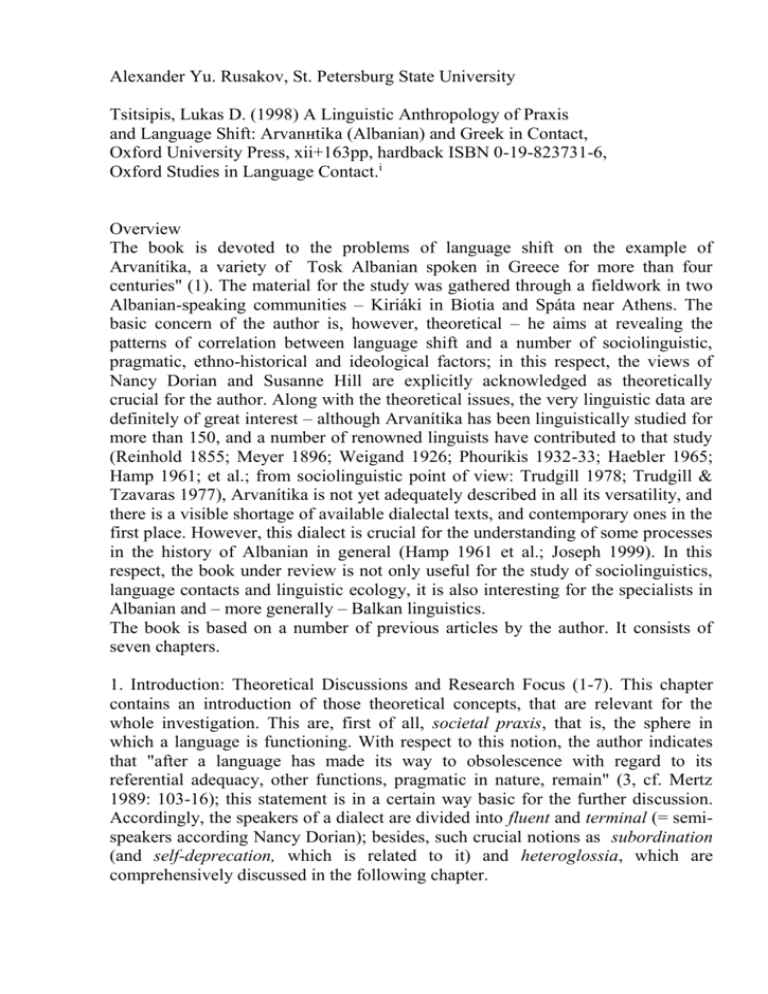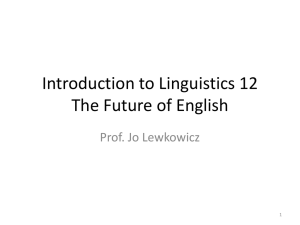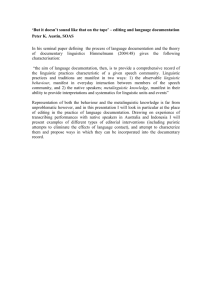tzip
advertisement

Alexander Yu. Rusakov, St. Petersburg State University Tsitsipis, Lukas D. (1998) A Linguistic Anthropology of Praxis and Language Shift: Arvanнtika (Albanian) and Greek in Contact, Oxford University Press, xii+163pp, hardback ISBN 0-19-823731-6, Oxford Studies in Language Contact.i Overview The book is devoted to the problems of language shift on the example of Arvanítika, a variety of Tosk Albanian spoken in Greece for more than four centuries" (1). The material for the study was gathered through a fieldwork in two Albanian-speaking communities – Kiriáki in Biotia and Spáta near Athens. The basic concern of the author is, however, theoretical – he aims at revealing the patterns of correlation between language shift and a number of sociolinguistic, pragmatic, ethno-historical and ideological factors; in this respect, the views of Nancy Dorian and Susanne Hill are explicitly acknowledged as theoretically crucial for the author. Along with the theoretical issues, the very linguistic data are definitely of great interest – although Arvanítika has been linguistically studied for more than 150, and a number of renowned linguists have contributed to that study (Reinhold 1855; Meyer 1896; Weigand 1926; Phourikis 1932-33; Haebler 1965; Hamp 1961; et al.; from sociolinguistic point of view: Trudgill 1978; Trudgill & Tzavaras 1977), Arvanítika is not yet adequately described in all its versatility, and there is a visible shortage of available dialectal texts, and contemporary ones in the first place. However, this dialect is crucial for the understanding of some processes in the history of Albanian in general (Hamp 1961 et al.; Joseph 1999). In this respect, the book under review is not only useful for the study of sociolinguistics, language contacts and linguistic ecology, it is also interesting for the specialists in Albanian and – more generally – Balkan linguistics. The book is based on a number of previous articles by the author. It consists of seven chapters. 1. Introduction: Theoretical Discussions and Research Focus (1-7). This chapter contains an introduction of those theoretical concepts, that are relevant for the whole investigation. This are, first of all, societal praxis, that is, the sphere in which a language is functioning. With respect to this notion, the author indicates that "after a language has made its way to obsolescence with regard to its referential adequacy, other functions, pragmatic in nature, remain" (3, cf. Mertz 1989: 103-16); this statement is in a certain way basic for the further discussion. Accordingly, the speakers of a dialect are divided into fluent and terminal (= semispeakers according Nancy Dorian); besides, such crucial notions as subordination (and self-deprecation, which is related to it) and heteroglossia, which are comprehensively discussed in the following chapter. 2. On the Politics of Change (8-20). This chapter introduces, as it were, the setting in which further action takes place. Some basic facts on the Albanians in Greece are provided, their self-nomination and the name for the Greek language used by them are discussed. Further on, within the frames of the history of Albanian community in Greece, the authors proceeds to the processes of subordination (without oppression) and self-deprecation (related to the former process), on the one hand, and heteroglossia, in which the Greek language plays the role of power code and Arvanítika, the role of solidarity code, on the other hand. The linguistic situation in the communities at issue leads to the establishment of "a certain kind of metapragmatic awareness in which an ethno-ideological view of language equates the use of Greek forms in the intracommunity sphere of communication with affectation" (15). Finally, the chapter contains a sociological and sociolinguistic description and comparison of two communities, namely, more industrialized Spáta and more patriarchal Kiriáki. It may be noticed, however, that a consistent comparison of linguistic data from these two communities was beyond the scope of the author’s objectives. 3. On Sociolinguistic Change (21-65). "The focus here is on both the structural and the sociolinguistic aspects of the shift" (6). This particularly informative chapter contains a compressive, but nonetheless useful review of the linguistic condition of the dialect, whereupon its conservative features, the patterns of adaptation of the Greek vocabulary, the models of interference – phonetic first of all – with Greek etc. are highlighted. Further on, the author compares the speech genres, typical of Arvanítika of the second half of 19th and beginning of 20th century, that are registered in the texts collected by Reinhold, Meyer and Phourikis (these are rather heterogeneous and encompass fairy tales, playful songs, speech plays, gospel excerpts; they entail, thus, a good preservation of full-fledged syntactic and morphological structures) with the scarce condition of contemporary narrative genres, that are poorly differentiated. A conclusion is made that a shift from internal heteroglossia (=fully functioning language) to heteroglossia juxtaposing Greek and Arvanítika has taken place. The following part is concerned with the structural changes resp. variation in the dialect. Based on sociolinguistic criteria the author distinguishes three types of changes, viz. completed, continuous and discontinuous changes. Completed changes "include those aspects of the Arvanitica grammatical system that are not part of any synchronic variation of the community" (34). Completed changes in Arvanítika are exemplified by the lack of admirative, fossilization of optative, and drastic decrease of productive derivative models (which is a pronounced symptom of language death, cf. for example Dressler 1996). It may remarked in passing, however, that it is not quite evident that Arvanítika had the category of admirative in the past; "some aspecrs of the history of the mood remains obscure" ( 34, n12). Continuous changes are such that the structures involved are "less produced and less recognized as we move from fluent to terminal speakers" (40). As an example of such a change the fate of Albanian gerund in Arvanítika is discussed. The texts gathered by the author have only four instances of constructions interpreted as gerundial; out of these two have the "tuke + finite form" structure, and it is not quite clear if these two utterances are simply agrammatical or they correspond to the construction typical of the Greek dialects of Albanian (this construction has been registered already by G.Meyer; it is not, as it were, found in other Albanian dialects, cf. Çabej 1976: 146-147). An auxiliary experiment in which subjects were supposed to translate sentences from Greek to Arvanítika with the use of gerundial constructions and to recognize such constructions in the Arvanítika sentences showed that the lower is the level of language competence of a paticular speaker, the less is productivity of the gerundial constructions. Unfortunately, the design of the experiment is described very briefly. The section devoted to discontinuous changes is particularly interesting. It is based on the analysis of Greek-to-Arvanítika translations provided fluent resp. terminal speakers. The two inflectional domains are at issue, that reflect the basic features of the Albanian grammatical system: the Nominal-Adjectival system (including agreement) and the Verb system (including syntactic subordination). Terminal speakers show the signs of utter decomposition of the grammatical system: there are abundant cases of omission of agreement markers, distortion of gender agreement, reordering of NP components, blunders in verb inflection, a good deal of disorder in the use of modal and tense forms, and numerous instances of the socalled fantasy morphology. In other words, pronounced symptoms of the later stages of language shift are observed. Summing up the "sociolinguistic" chapter, the author concludes that the notion of compromise suggested by Nancy Dorian seem applicable to the sociolinguistic situation in Arvanítika (cf. "If in a small linguistic community the threatened language does not face puristic pressures a serviceable form of the language may well continue in use. On the other hand, the lack of puristic stances causes a relaxation of corrective constraints and so makes possible the emergence of agrammatisms", 63). 4. Performance and Ethnohistory (66-96). This chapter deals with the speech behavior of fluent speakers. Their narrative performance ("specific use of language by which the speaker assumes responsibility for the display of communicative competence to an evaluating audience", 66) is characterized by three major devices: narrative markers (hearer-oriented expressions and "formulaic material which serves as a frame-opener for the performance of the genre", 72), samelanguage repetitions (the device "serves the purpose of effecting a shift to a substantially new information unit in the development of the narrative plot", 73) and couplings (instances of code switching). Besides, the author discusses those obstacles that can be encountered by fluent speakers in the process of narrative performance; these are first of all not appropriate conduct of terminal speakers involved in the communication and possible attendance of Greek monolinguals among the hearers. The major part of the chapter is devoted to a deep and meticulous analysis of several narrative texts, in which narrative devices (partially discussed above) are related to the development of the plot. One of the main conclusions on this stage is that the narratives are dialogical (in Bakhtin’s terms) in nature, which reflects "the conflict between the two worlds, the traditional, Arvanítika-dominant, and the modern, Greek-dominant", 82); this dialogical nature could manifest itself in codeswitching, but not entirely in it. Language shift is reflected in a specific double-voiced character of narratives, where "the conflict [exists] between a positive cultural stance towards Arvanítika and a pragmatism concerning sociocultural and linguistic change" (84); this conflict leads in a progress towards the Greek language. The chapter is concluded by an interesting analysis of a long narrative of an uncle J., one of the last fluent speakers of the community of Livanátes, where the Arvanítika is nearly extinct. This uncle J. demonstrates a certain degree of agrammatism; nonetheless, "uncle J. furnishes a poetically complex speech segment…. there is an ambiguity deriving from the sociological condition of last, but not terminal speakers" (95). 5. The Contextualization of Terminal-Speaker Discourse and the Production of an Across-the-Border Voice: Beyond Grammar (96-117). This chapter contains a discussion of the speech behavior of terminal speakers. Analyzing the dialogues, in which – as a rule – fluent speakers take part along with the terminal speakers, the author characterizes the speech behavior of the latter as across-the-border voice. Terminal speakers show almost complete loss of the referential function of the language, Arvanítika is only used for the expression of their attitudes towards the native language and their own speech community. These attitudes are thoroughly analyzed in the chapter. The texts produced by terminal speakers are characterized in the chapter as slim texts, that is, the texts that hold somewhat intermediate position between formulae and long narratives. 6. The Coding of Linguistic Ideology and Arvanítika Language Shift (118-143). While the two foregoing chapters are devoted to the analysis of the texts produced by fluent resp. terminal speakers, the 6th chapter tackled the problem of linguistic ideology expressed in these texts. The two types of ideological discourse are distinguished, namely, congruent and contradictory. The former corresponds to the phenomenon of subordination ("I call congruent discourse the type of linguistic ideology in which the hegemonic effects of subordination show up: in this discourse speakers do not juxtapose the two codes of their repertoire in any contradictory manner", 120), the latter one reflects the situation of heteroglossia ("I call contradictory discourse the type of discursively surfacing linguistic ideology in which the expression of the solidarity function of Arvanítika is interrupted by the power function of Greek", 120). An analysis of several narratives representing the two distinguished types is provided. With respect to the contradictory discourse an important notion of performative contradiction is introduced; this terms refers to those cases in which the attitude of a speaker towards a certain phenomenon undergoes a change in the process of narration. In the analysis of the internal dialogical structure of such narratives the author notably relies on the ideas of Bakhtin - Vološinov (Vološinov 1973), in particular, he uses their terms of anticipated and disseminated reported speech. In the second half of the chapter, an endeavor is made to decompose the ideology expressed in the narratives into component nuclei. Four nuclei (=ideas) are distinguished based on the analysis of the texts: (1) "In earlier times people suffered due to the harsh material conditions prevailing then, but moral principles were kept in high esteem…; (2) The calendrical order of socio-religious life was strictly observed then as against today when it is not. (3) Social roles were predeterminated by the norm so that things were not left to the chancy turns of life as against today when we are witnessing a moral loosening of human conduct… (4) The Arvanítika language was once pure and people spoke without mixing their language with Greek whereas today Arvanítika has become a bastard language" (132). The author notes that mentioning one of these nuclei often leads to the evolvement of the others. 7. Concluding Remarks on Ideology and Shift: Language Ideology as a Discursive and Reconstructible Phenomenon (144-146). This short chapter summarizes the message of the book. It is emphasized that language ideology is reconstructible phenomenon, that is analysis of the arrangement of the elements of the narrative allows one to reconstruct the speakers’ views on the causal relationships between the phenomena of spiritual and social life. Evaluation The book by L.Tsitsipis is extremely informative and essential. Despite its relatively small size it contains a meticulous discussion of a significant number of problems ranging from structural changes under the process of language shift to linguistic ideology and the ways it is expressed in narratives. The logical consistence of the discussion of the data is undisputable, there is clear and ensuing structure of author’s thinking reflected in the "plot" of the book. Theoretical conclusions are deeply grounded empirically. Several remarks to follow are not in fact deemed as polemic; rather, they are questions and suggestions that arise inevitably in the process of reading an interesting and informative scholarly research. Although the distinction of fluent and terminal speakers seems quite convincing as such, the very consistency of the former group needs some clarification. On page 140 the author makes an interesting remark that (some?) "Arvanítika-dominant bilinguals make frequent errors in Greek". Thus the question arises if there is a group of balanced bilinguals, and if yes, how can their performance be characterized. It remains somewhat unclear, if the speakers of Arvanítika are homogenous enough with respect to the linguistic ideology, that can be understood based on their narratives, in other words, if there are any discrepancies or gradations between speakers as regards their ideology. The very possibility of the ideological heterogeneity of a speech community, that is, the possibility of the coexistence of several subgroups of a community differing in their metalinguistic awareness with respect to the "dialect vs. standard language" or "first language vs. second language" opposition is quite imaginable (cf. Rusakov, Sai forthcoming for the description of such a community). It would be crucial for the understanding of the sociolinguistic patterns of language use in the speakers of Arvanítika to make an in-depth study of the processes of code-switching in the speech of different groups of these speakers. Besides, it could have been appropriate to provide a general description of the narrative material: it remains unclear what kind of narrative plots are encountered along with those discussed in the book (if there are any at all?). The author clearly aimed at the description of the situation of language shift in Arvanítika and not at understanding whether the patterns revealed are generally typical of sociolinguistic situations characterized by a strong functional distribution of two (or more) co-existing languages. However, in the course of moving along his line of argumentation the author repeatedly draws reader's attention to various sociolinguistically similar situations. It could have been germane to bundle together these typological observations in order to create a kind of a background for the discussion of particular phenomena revealed in Arvanítika communities. Needless to say that all these remarks to do not change the fact that the book by Lucas Tsitsipis deserves a very high evaluation. Bibliography: Çabej, Eqrem. Studime gjuhesore. V. 1, Prishtine, 1976. Dressler, Wolfgang. 1996. Language Death. In Singh, Rajendra, ed., Towards a Critical Sociolinguistics. Amsterdam: Benjamins, 195-210. Haebler, Claus. 1965. Grammatik der Albanischen Mundart von Salamis. Wiesbaden: Otto Harassowitz. Hamp, Eric P.1961. On the Arvanítika dialects of Attica and the Megari. Balkansko Ezikoznanie) Linguistique Balkanique), 3, 101-106. Joseph, Brian D. 1999. Comparative perspectives on the place of Arvanitika within Greece and the Greek environment. In: L.Tsitsipis (ed.). Arvanitika ke Elinika: Zitimata Poliglosikon ke Polipolitismikon Kinotiton. Vol. II. Livadia: EXANDAS, 208-214. Meyer, Gustav. 1896. Albanesische Studien. V. Beitraege zur Kenntniss der in Griechenland gesprochenen Albanesischen Mundarten (Wien: Wiener Akademie Sitzungsberichte). Mertz, Elizabeth. 1989. Sociolinguistic Creativity: Cape Breton Gaelic’s linguistic "tip". In: Dorian, Nancy (ed.). Investigating Obsolescence: Studies in Language Contraction and Death. Cambridge: CUP, 103-116. Phourikis 1932-33; The Greek-Albanian dialect in Attika [in Greek]. Athina, 44, 28-76; 45, 49-181. Reinhold, Carol H. 1855. Noctes Pelasgicae. Athens: Typis Sophoclis Carbola. Rusakov, Alexander & Sergei Sai. Forthcoming. On metalinguistic awareness and self-identification of a dialect speaker. Trudgill, Peter. 1978. Creolization in reverse: reduction and simplification in the Albanian dialects of Greece. Transactions of the Philological Society, 1976-7, 3250. Trudgill, Peter & Tzavaras, George. 1977. Why Albanian-Greeks are not Albanians: Language shift in Attica and Biotia. In: Giles, H. (ed.). Language, Ethnicity and Intergroup Relations, New York: Academic Press. 171-184. Vološinov, Valentin N. 1973. Marxism and the Philosophy of Language, trans. L.Matejka and I.R.Titunik. Cambridge, Mass.: Harvard University Press. Weigand, Gustav. 1926. Das Albanische in Attika. Balkanarchiv, 2, 167-220. Данная рецензия первоначально была опубликована в электронном виде на сайте Linguistlist (http://linguistlist.org/issues/13/13-3170.html). i







